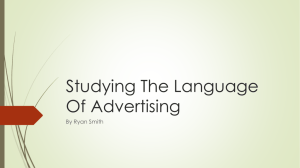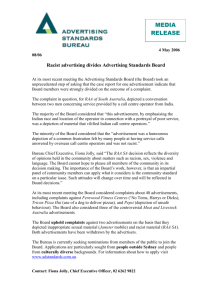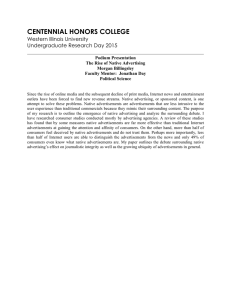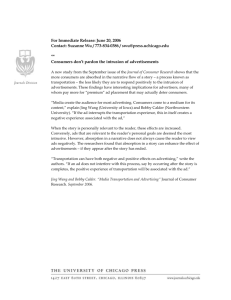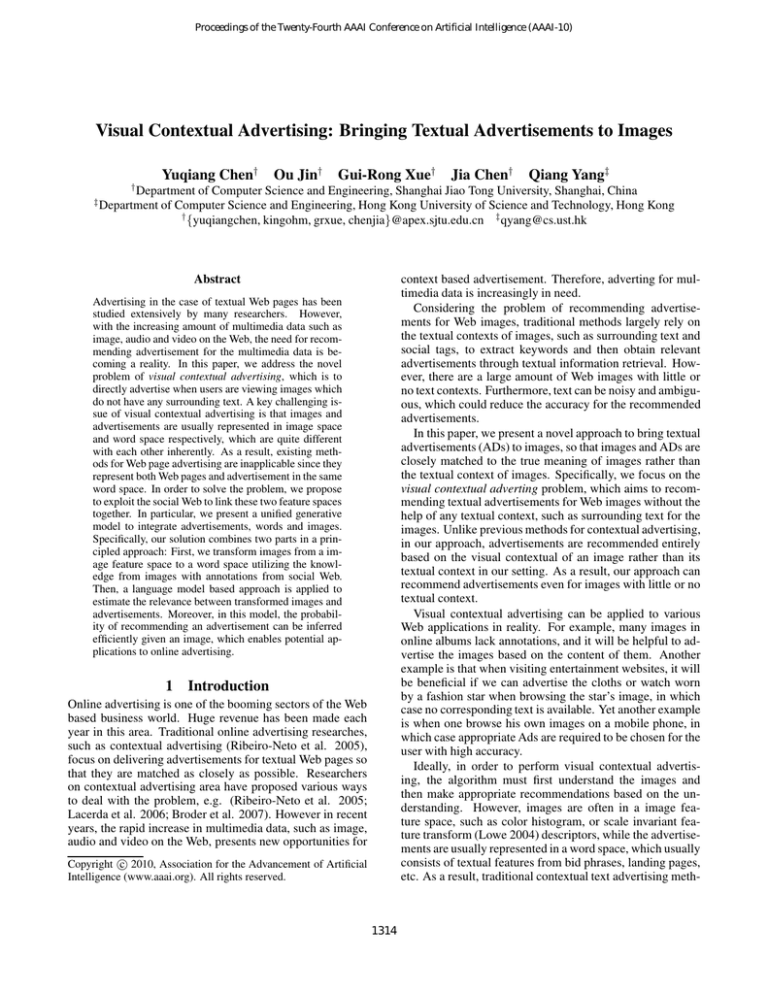
Proceedings of the Twenty-Fourth AAAI Conference on Artificial Intelligence (AAAI-10)
Visual Contextual Advertising: Bringing Textual Advertisements to Images
Yuqiang Chen†
Ou Jin†
Gui-Rong Xue†
Jia Chen†
Qiang Yang‡
†
‡
Department of Computer Science and Engineering, Shanghai Jiao Tong University, Shanghai, China
Department of Computer Science and Engineering, Hong Kong University of Science and Technology, Hong Kong
†
{yuqiangchen, kingohm, grxue, chenjia}@apex.sjtu.edu.cn ‡ qyang@cs.ust.hk
Abstract
context based advertisement. Therefore, adverting for multimedia data is increasingly in need.
Considering the problem of recommending advertisements for Web images, traditional methods largely rely on
the textual contexts of images, such as surrounding text and
social tags, to extract keywords and then obtain relevant
advertisements through textual information retrieval. However, there are a large amount of Web images with little or
no text contexts. Furthermore, text can be noisy and ambiguous, which could reduce the accuracy for the recommended
advertisements.
In this paper, we present a novel approach to bring textual
advertisements (ADs) to images, so that images and ADs are
closely matched to the true meaning of images rather than
the textual context of images. Specifically, we focus on the
visual contextual adverting problem, which aims to recommending textual advertisements for Web images without the
help of any textual context, such as surrounding text for the
images. Unlike previous methods for contextual advertising,
in our approach, advertisements are recommended entirely
based on the visual contextual of an image rather than its
textual context in our setting. As a result, our approach can
recommend advertisements even for images with little or no
textual context.
Visual contextual advertising can be applied to various
Web applications in reality. For example, many images in
online albums lack annotations, and it will be helpful to advertise the images based on the content of them. Another
example is that when visiting entertainment websites, it will
be beneficial if we can advertise the cloths or watch worn
by a fashion star when browsing the star’s image, in which
case no corresponding text is available. Yet another example
is when one browse his own images on a mobile phone, in
which case appropriate Ads are required to be chosen for the
user with high accuracy.
Ideally, in order to perform visual contextual advertising, the algorithm must first understand the images and
then make appropriate recommendations based on the understanding. However, images are often in a image feature space, such as color histogram, or scale invariant feature transform (Lowe 2004) descriptors, while the advertisements are usually represented in a word space, which usually
consists of textual features from bid phrases, landing pages,
etc. As a result, traditional contextual text advertising meth-
Advertising in the case of textual Web pages has been
studied extensively by many researchers. However,
with the increasing amount of multimedia data such as
image, audio and video on the Web, the need for recommending advertisement for the multimedia data is becoming a reality. In this paper, we address the novel
problem of visual contextual advertising, which is to
directly advertise when users are viewing images which
do not have any surrounding text. A key challenging issue of visual contextual advertising is that images and
advertisements are usually represented in image space
and word space respectively, which are quite different
with each other inherently. As a result, existing methods for Web page advertising are inapplicable since they
represent both Web pages and advertisement in the same
word space. In order to solve the problem, we propose
to exploit the social Web to link these two feature spaces
together. In particular, we present a unified generative
model to integrate advertisements, words and images.
Specifically, our solution combines two parts in a principled approach: First, we transform images from a image feature space to a word space utilizing the knowledge from images with annotations from social Web.
Then, a language model based approach is applied to
estimate the relevance between transformed images and
advertisements. Moreover, in this model, the probability of recommending an advertisement can be inferred
efficiently given an image, which enables potential applications to online advertising.
1 Introduction
Online advertising is one of the booming sectors of the Web
based business world. Huge revenue has been made each
year in this area. Traditional online advertising researches,
such as contextual advertising (Ribeiro-Neto et al. 2005),
focus on delivering advertisements for textual Web pages so
that they are matched as closely as possible. Researchers
on contextual advertising area have proposed various ways
to deal with the problem, e.g. (Ribeiro-Neto et al. 2005;
Lacerda et al. 2006; Broder et al. 2007). However in recent
years, the rapid increase in multimedia data, such as image,
audio and video on the Web, presents new opportunities for
c 2010, Association for the Advancement of Artificial
Copyright Intelligence (www.aaai.org). All rights reserved.
1314
syntactic features to calculate the relevance score between a
web page and advertisements (Broder et al. 2007).
All the mentioned studies intend to advertise based on
textual web page context, rather than visual textual. Mei,
Hua, and Li presented a novel contextual advertising algorithm using both surrounding textual information and local
visual relevance (Mei, Hua, and Li 2008). An image advertisement would be seamlessly inserted into the target image
relying on a saliency map. However in (Mei, Hua, and Li
2008), image information was mainly used as a complement
for textual annotation when annotations were insufficient or
the quality was low. In this paper, we consider a more challenging scenario where no surrounding text is given and advertisements are recommended entirely based on the visual
context.
Figure 1: An illustrative example of our solution for visual
contextual adverting problem. Originally images are represented in different feature space from advertisements, which
poses difficulties for advertising. With the help of annotation
data from social Web, we can link the images and advertisements, and thus advertise directly based on the context of
images.
2.2 Image Annotation
Another closely related area is image annotation. Duygulu
et al. regarded the image annotation as a machine translating process (Duygulu et al. 2002). Some other researchers
model the joint probability of images regions and annotations. Barnard et al. (Barnard et al. 2003) investigated image
annotation under probabilistic framework and put forward a
number of models for the joint distribution of image blobs
and words . Blei and Jordan (Blei and Jordan 2003) developed correspondence latent Dirichlet allocation to model
the joint distribution. In (Jeon et al. 2003), continuousspace relevance model was proposed to better handle continues features and be free from the influence of image blobs
clustering. In (Carneiro et al. 2007), image annotation is
posed as classification problems where each class is defined
by images sharing a common semantic label. While visual
contextual advertising presented in this paper has some similarity with image annotation, some key differences exist.
A major difference is that the advertisements correspond to
groups of fixed keywords rather than collections of independent keywords as in the case of image annotation. As such,
there is a need to tradeoff advertisement selection with the
accuracy of individual words. Advertisement selection also
relates to diversity of selected advertisements as a whole,
and other important factors such profit.
ods are unable to handle this problem.
In order the overcome the above-mentioned problems,
we exploit the annotated image data from social Web sites
such as Flickr1 to link the visual feature space and the word
space. An illustrative example of our proposed method for
visual contextual advertising is given in Figure 1. To be specific, we present a unified generative model, ViCAD, to deal
with the visual contextual advertising. ViCAD runs in several steps. First, we model the visual contextual advertising
problem with a Markov chain which utilizes annotated images to transform images from the image feature space to
the word space. With the representations of images in word
space, a language model for information retrieval is then applied to find the most relevant advertisements. Moreover,
we show that the inference of the model can be performed
efficiently by constraining the word space for representing
image to be a smaller subspace, which allows potential applications of using our model in online image advertising.
3 ViCAD Algorithm for Visual Contextual
Advertising
2 Related Work
2.1
Contextual Advertising
3.1 Problem Formulation
The online advertising problem is getting increasingly important with the development of the Web business. A popular approach in online advertising is contextual advertising, which is to place advertisements in a target web page
based on the similarity between the content of target page
and advertisement description. Various researchers have addressed the problem of contextual adverting (Ribeiro-Neto
et al. 2005; Lacerda et al. 2006; Broder et al. 2007). In
(Ribeiro-Neto et al. 2005), ten strategies of contextual advertising were proposed and compared. Lacerda et al. proposed a framework using learning method based on genetic
programming . Broder et al. combined the semantic and
1
First we define the problem of visual contextual advertising formally. Let W = {w1 , w2 , . . . , wm } be the vocabulary space, where wi is a word and m is the size of vocabulary. Let T be the advertisement space. In this space,
each advertisement ti ∈ T is represented by a feature vector
(t1i , t2i , . . . , tm
i ) on the word space W . We denote V as the
image space, in which each image vi ∈ V is represented by
feature vector (vi1 , vi2 , . . . , vin ) on the image feature space
F = {f1 , f2 , . . . , fn }. To link two different feature spaces,
the word space and the image feature space, we make use of
|D|
auxiliary annotated image data D = {(vi , wi )}i=1 , where
vi ∈ V and wi ∈ W are a image-word pair which is semantically related.
http://www.flickr.com
1315
lar advertisement. Therefore, Eq. (2) can be reformed as
X
Y
Pr(t|v) ∝
Pr(f |w) . (3)
Pr(w|t)
|
{z
}
|
{z
}
w
language model
f ∈v
feature translator
From Eq. (3), it is clear that our model can be decomposed into two parts. The first part Pr(w|t) can be estimated
using a language model. The second part is the product of
probabilities of image features give a word, Pr(f |w), which
requires a feature translator in order link the image feature
and word space. We will describe how to estimate these two
parts in the following subsections.
Parameter estimation of Pr(w|t) via language model
Statistical language model is originally used in speech
recognition, machine translation problems. With the develop of information retrieval, researchers begin to introduce the language models into the information retrieval area
(Ponte and Croft 1998).
In this paper, we estimate the probability Pr(w|t) via
a language model. The unsmoothed language model of
Pr(w|t) is given by the maximum likelihood estimation
Figure 2: Graphical model representation of ViCAD model.
In this figure t represents an advertisement, w represents a
word and f represents an image feature. nt is the number
of words in t and nw is the number of image features corresponding to w.
n(w, t)
.
′
w ′ ∈t n(w , t)
Prml (w|t) = P
where n(w, t) is the number of occurrences a word w in advertisement t.
However, Eq. 4 underestimates the unseen words in the
advertisements. Many researchers have proposed smoothing
methods to overcome the problem (Jelinek and Mercer 1980;
Zhai and Lafferty 2004). We utilize the Jelinek-Mercer’s
smoothing method (Jelinek and Mercer 1980; Hiemstra
2002) in the model estimation. Jelinek-Mercer’s smoothing
involves a linear interpolation between the maximum likelihood model of an advertisement and the model of all advertisements, with a coefficient λ controlling the influence of
those two models. Formally,
The image set to be advertised is denoted as I. For each
image v ∈ I, the objective is to find a function hv (t) : T 7→
R that estimates the relevance between a given image v and
an advertisement t as accurately as possible.
3.2
Visual Contextual Advertising Model
This section gives a detailed description of our model for visual contextual advertising. Our assumption is that given the
word space W, the advertisements T and the image features
F are conditionally independent. Under the independence
assumption of words in advertisements, the joint distribution
of t, w, and v is given by
Pr(t, w, v)
= Pr(t) Pr(w|t) Pr(v|w)
Y
= Pr(t) Pr(w|t)
Pr(f |w).
f ∈v
Pr(w|t) = (1 − λ) · Prml (w|t) + λ · Pr(w|T ).
, Pr(t|v) =
Parameter estimation of Pr(f |w) via social annotation
data Since Pr(f |w) involves two feature spaces, the image feature and word space, we can not estimate the Pr(f |w)
directly. Intuitively we want to find a kind of data that act as
a bridge for transferring knowledge between different kinds
of knowledge sources. In this work, we choose to use socially annotated images from the Web, such as Flickr, as a
bridge to link the word and image feature spaces. We assume
a Markov chain w → v → f underlying the image-word cooccurrence data and image features. Then Pr(f |w) can be
decomposed as
X
Pr(f |w) =
Pr(f |v) · Pr(v|w) .
(6)
| {z }
| {z }
v
X Pr(t, w, v)
Pr(v)
Y Pr(f |w)
Pr(t) Pr(w|t)
.
Pr(v)
w
=
X
w
(5)
where T is the advertisement space containing all the advertisements. In practise, we can effectively calculate Pr(w|t)
without enumerating all the advertisements by using a index.
More detailed descriptions would be given in Section 3.3 .
(1)
The graphical model representation of our proposed model
ViCAD is shown in Figure 2.
The objective of visual contextual advertising hv (t) is set
to be Pr(t|v) in this paper, which can be computed using
hv (t)
(4)
(2)
f ∈v
Since we keep an image v fixed to find related advertisements, Pr(v) in Eq. (2) can be omitted. Furthermore, we
assume the prior over words Pr(t) to be uniform since we
do not have any preference or prior knowledge on a particu-
feature extractor
1316
co-occurrence data
O(nzad ) where nzad is the number of nonzero items in the
advertisement-word co-occurrence matrix, which is proportional to the input of advertisements.
However when nzad is very large, the computation can
be potentially expensive. In order to furthermore accelerate our algorithm, instead computing Pr(t|v) under
the word space W, we calculate under a smaller subspace
of W. Formally
we use the formula Pr(t|v) =
P
Q
of Eq. 3, where W ′
w∈W ′ Pr(w|t)
f ∈v Pr(f |w) instead
Q
is the set of word with large values of f ∈v Pr(f |w). This
approximation would not affects the result of our objective
of ad recommendation
significantly since those words with
Q
small f ∈v Pr(f |w) do not tend to affects the final ranking
of hv (t) , Pr(t|v) much. Therefore the complexity of com′
′
puting Pr(w|t) turns into O(nzad
) where nzad
is the number of nonzero items in the advertisement-subword space
W ′ co-occurrence matrix.
The time cost for computing Pr(t|v) based on Pr(t|w)
and Pr(f |w) is O(|W| · |F |).
To sum up, the total time cost of ViCAD is
′
O (|I| · (nzad
+ |W| · |F |) + |F | · |D|). In practise, |W| ·
′
|F | is usually much smaller than nzad
. In addition, |F | can
be taken as a constant usually no larger than 1000. So the
′
overall complexity of algorithm ViCAD is O(|I| · nzad
+
|D|), which shows our algorithm is quite scalable and fitful
for online applications.
Algorithm 1 Visual Contextual Adverting (ViCAD) Algorithm.
Input: Image set I which is to be advertised, auxiliary image word concurrence data D, target advertisement set T .
Output: hv (t) for each v ∈ I and t ∈ T .
1: for all w ∈ W do
2:
for all f ∈ F do
3:
Calculate Pr(f |w) based on D and Eq. (6), (7), (8).
4:
end for
5: end for
6: for all v ∈ I do
7:
for all t ∈ T do
8:
for all w ∈ W do
9:
Calculate Pr(w|t) based on Eq. (5).
10:
end for
11:
Calculate Pr(t|v) based on Pr(w|t), Pr(f |w) and
Eq. (3)
12:
end for
13: end for
14: return: Pr(t|v) as hypothesis hv (t).
The probability Pr(v|w) in Eq. 6 can be estimated with
|D|
image-word co-occurrence data D = {(vi , wi )}i=1 using:
Pr(v|w) = P
#{(v, w)|(v, w) ∈ D}
.
′
′
v ′ #{(v , w)|(v , w) ∈ D}
(7)
4
Another probability in Eq. 6, Pr(f |v), can be estimated
by first applying a feature extractor, such as SIFT (scale invariant feature transform) (Lowe 2004), on v, which is used
for converting v into a vector on a image feature space F ,
and then be estimated using
n(f, v)
Pr(f |v) = P
.
′
′
f ∈F n(f , v)
4.1 Data Sets
In order to evaluate our algorithm ViCAD, we conduct experiments on two image corpora, Flickr Images2 and Fifteen scene categories (Lazebnik, Schmid, and Ponce 2006).
Flickr is a social network website where users can freely
upload images and add annotations to images. We crawled
59,759 image from Flickr during May to August 2009. Semantic topics of images in Flickr varied widely from artifacts for nature, from human to animal. The Fifteen scene
categories is a publicly available image data set of 4,485 images containing fifteen different scenes such as store and
forest. From these two corpora, we randomly select 200
images from each data set as the evaluation data sets.
Our advertisement data were crawled from the MSN
search engine3 in 2008. First, a list of popular queries were
selected from AOL query log, and then with this query list
we searched using MSN search engine to obtain the advertisements appearing in the search results. Overall, 312,759
advertisements with both title and content were crawled as
our advertisement set.
As described in the Section 3.3 , in order to link the
spaces of image feature and word, we used image-word cooccurrence data in Flickr as the auxiliary data. Since the
(8)
where n(f, v) is the number of occurrences of image feature
f appearing in image v.
3.3
Experiments
In this section, we describe the data used in our experiment and empirically analyze the effective of our algorithm
ViCAD on two different image corpora.
Algorithm and Complexity Analysis
A formal description of our algorithm of visual contextual
advertising, named ViCAD, is given in Algorithm 1. Step
1 to Step 5 estimate the model parameters required by the
algorithm. Step 6 to Step 13 generate a hypothesis that measures the relevance of an image to advertisements for every
image v ∈ I and advertisement t ∈ T . Pr(t|v) is returned
as the final hypothesis.
The time cost for computing Pr(f |w) is O(|F | · |D|),
where F is image feature space and D is the auxiliary word
image co-occurrence data. Next we investigate the time cost
for computing Pr(w|t) for all t ∈ T and w ∈ W. Recall
our computation of Pr(w|t) via language model in Eq. 5,
Pr(w|t) equals λ · Pr(w|T ) when word w does not occur
in t. Since λ · Pr(w|T ) is a constant with respect to all advertisements t, when calculating Pr(w|t) we only need to
consider the advertisements which contain word w. With a
inverted index on advertisements, this can be achieved efficiently. Therefore the time cost of computing Pr(w|t) is
2
3
1317
http://www.flickr.com
http://search.msn.com
(a) Flickr image set
(b) Fifteen scene data set
Figure 3: Figure representation of P@n results of all compared methods with respect to Flickr and Fifteen scene data sets.
original Flickr annotations are quite noisy, we manually selected 1,055 nouns of widely seen general objects, such as
apple, building or mountain, as the word space W. Word
selection is independent of advertisements since we would
like to have a general purposed word space. Based the selected words and images we crawled, we obtained 673,547
image-word co-occurrence data from Flickr, which form our
auxiliary data D. Note that in our experiments, images for
evaluating ad-recommendation are different from those images used as auxiliary data.
Data preprocessing is applied to the raw data. We use
the “bag-of-words” model (Li and Perona 2005) to represent each image. First interesting point were detected and
described by SIFT descriptor (Lowe 2004). Then we cluster
a randomly sample subset of all interesting points to obtain
a codebook, which is our image feature space F . Similar to
(Sivic et al. 2005), we set the number of clusters to be 1,000.
Using this codebook, each image is converted into a vector
for further ad-recommendation uses.
As mentioned in the Section 3.3 , we use the inverted index to accelerate the computation of Pr(w|t). For each advertisement, its title and content are concatenated, and then
be indexed using Lucene4 . To further accelerate computation, a smaller word space W ′ is exploited (refer to Section
3.3). The size of W ′ is set to ten in all our experiments. The
smoothing parameter λ for the language model in Eq. 5 is
set to be 0.15 as indicated in (Jelinek and Mercer 1980).
4.2
n
1
2
3
4
5
6
7
8
9
10
F LICKER DATA
A+S
ViCAD
UB
0.280
0.342
0.362
0.276
0.334
0.359
0.266
0.324
0.352
0.262
0.321
0.351
0.261
0.319
0.342
0.259
0.316
0.338
0.255
0.309
0.337
0.253
0.303
0.338
0.249
0.297
0.329
0.246
0.291
0.322
F IFTEEN S CENE DATA
A+S
ViCAD
UB
0.310
0.338
0.39
0.307
0.336
0.395
0.302
0.332
0.397
0.297
0.329
0.398
0.298
0.331
0.398
0.297
0.329
0.398
0.295
0.328
0.398
0.295
0.329
0.398
0.294
0.329
0.398
0.296
0.331
0.398
Table 1: The P@n results of all compared methods with
respect to Flickr and Fifteen scene data sets. Due to space
limitation, Search+Annotation is abbreviated as A+S,
and Upperbound is abbreviated as UB.
data set, the true labels are the tags annotated by users, while
in Fifteen scene data set, the true labels are the scene names
of images. Notice that the Upperbound method is unavailable in our visual contextual advertising problem setting since no textual knowledge about an image is given. In
our experiments, the upper bound is used for reference.
As for evaluate metrics, we choose the precision at n (or
P@n), which is the portion of related advertisements on the
topmost n recommendations to evaluate the experimental results. To obtain ground truth results, four participants manually judged whether target images and advertisements are
relevant or not. The final result is the average precision of
all participants.
Evaluation Methods
Since few existing work investigate the problem of visual
contextual advertising to our best knowledge, we compare
our algorithm with two baselines. One baseline is to first
annotate images (Makadia, Pavlovic, and Kumar 2008)5 and
then search for related advertisements based on the annotations. We refer to this baseline as Annotation+Search.
The other baseline is the upper bound performance of recommending advertisements. To estimate upper bound, we
peek the true labels of the images used for evaluation and
search for the related advertisements in T , to which we referred to as Upperbound method. Specifically in Flickr
4.3 Empirical Analysis
The P@n results with respect to Flickr and Fifteen scene
data sets are given in Figure 3. Detailed results are given
in Table 1. On one hand, ViCAD shows comparable performance to the Upperbound on both data corpora. On
the other hand, we can see that ViCAD performs better than
Annotation+Search regardless the number of advertisements recommended. This indicates that ViCAD, which
integrates the visual contextual advertising into a unified
model, performs better than adverting with two separate process.
One reason why the performance of Upperbound on
Flickr data set is not as good as on Fifteen scene data set
4
http://lucene.apache.org/
We adapted color features and SIFT feature as basic features
and combined them using joint equal contribution (JEC).
5
1318
F LICKR DATA S ET
F IFTEEN S CENE DATA S ET
Dog, cat, fish, bird, reptile supplies
Ocean beach flower delivery
Find all reptile supplies online
Ocean drive beach flower delivery
Positron emission tomography, PET scan
Ocean Isle beach flower delivery
Scenery hill flower delivery
Send a gift tower or gift baskets.
Lake hill flower delivery
Shop for kitchen wall tiles
Twin lake hill flower delivery
Shop for wall stencil
Humour plants excellence
Master building products Pte Ltd
Shop for nursery plants
Shop for building materials
Nursery plants
CTC holidays
You can sail round the world!
Buy or sell cars, cars items on eBay
Shop for pontoon boat
Car loan calculator
Bass boat shoes
Buy used cars
Table 2: The visual contextual adverting results with respect to Flickr and Fifteen scene data sets. Texts given in right of each
image are the top three advertisements recommended by our algorithm ViCAD.
lies in the quality of labels of the images. The Fifteen scene
data consists of limited number of scenes and images were
delicately selected by human. Therefore the quality of labels is quite high. Nevertheless the Flickr data set contains
images with far more scenes and labels were annotated by
Web users, which in turn leads to noise in the labels. However, comparing the result of our algorithm ViCAD on those
two data sets, the performance difference is not large especially for those top three recommended advertisements.
This demonstrates that our algorithm is an effective solution
when no label or only noisy labels of an image are given.
Table 2 shows the visual contextual adverting result of our
algorithm ViCAD with respect to Flickr and Fifteen scene
data sets. In this figure, images in the first column are the images from Flickr data set and images in the second column
are the images from Fifteen scene data set. Top three advertisement recommendations are given on the right of each
image. From the table we can see that our algorithm can
indeed find related advertisements based on the visual contextual information of an image. Moreover on our dual core
2.4GHz CPU PC, our algorithm without full optimization
takes only about 0.2s to advertise an image, which empirically shows our algorithm is quite efficient and applicable
for online applications in practice.
NSFC project (No. 60873211), RGC/NSFC project (No.
60910123) and Open Project Program of the state key lab of
CAD & CG (No. A0801), Zhejiang University. Qiang Yang
thanks the support of RGC/NSFC project N HKUST624/09.
References
Barnard, K.; Duygulu, P.; Forsyth, D.; de Freitas, N.; Blei, D. M.;
and Jordan, M. I. 2003. Matching words and pictures. J. Mach.
Learn. Res. 3:1107–1135.
Blei, D. M., and Jordan, M. I. 2003. Modeling annotated data. In
SIGIR ’03, 127–134.
Broder, A.; Fontoura, M.; Josifovski, V.; and Riedel, L. 2007. A
semantic approach to contextual advertising. In SIGIR ’07, 559–
566.
Carneiro, G.; Chan, A. B.; Moreno, P. J.; and Vasconcelos, N.
2007. Supervised learning of semantic classes for image annotation
and retrieval. IEEE Trans. Patt. Anal. Mach. Intell. 29(3):394–410.
Duygulu, P.; Barnard, K.; Freitas, J. F. G. d.; and Forsyth, D. A.
2002. Object recognition as machine translation: Learning a lexicon for a fixed image vocabulary. In ECCV ’02, 97–112.
Hiemstra, D. 2002. Term-specific smoothing for the language modeling approach to information retrieval: the importance of a query
term. In SIGIR ’02, 35–41.
Jelinek, F., and Mercer, R. 1980. Interpolated estimation of markov
source parameters from sparse data. Pattern Recognition in Practice.
Jeon, L. M.; Lavrenko, V.; Manmatha, R.; and Jeon, J. 2003. A
model for learning the semantics of pictures. In NIPS ’03. MIT
Press.
Lacerda, A.; Cristo, M.; Gonçalves, M. A.; Fan, W.; Ziviani, N.;
and Ribeiro-Neto, B. 2006. Learning to advertise. In SIGIR ’06,
549–556.
Lazebnik, S.; Schmid, C.; and Ponce, J. 2006. Beyond bags of
features: Spatial pyramid matching for recognizing natural scene
categories. In CVPR’ 06, 2169–2178.
Li, F.-F., and Perona, P. 2005. A bayesian hierarchical model for
learning natural scene categories. In CVPR’ 05, 524–531.
5 Conclusion
In this paper, we proposed a new approach for Web based
advertising, called image contextual advertising, which is to
advertise an image without the help of any surrounding text.
A unified generative model was applied to model the advertisements, words, and image features. Based on the model,
we proposed an algorithm called ViCAD, and showed how
to accelerate inference and analyzed the complexity. Finally we performed experiments on two image data sets and
demonstrated the effectiveness of our algorithm.
Acknowledgement Gui-Rong Xue thanks the support of
1319
Lowe, D. G. 2004. Distinctive image features from scale-invariant
keypoints. IJCV 60:91–110.
Makadia, A.; Pavlovic, V.; and Kumar, S. 2008. A new baseline
for image annotation. In ECCV ’08, 316–329.
Mei, T.; Hua, X.-S.; and Li, S. 2008. Contextual in-image advertising. In ACM MULTIMEDIA ’08, 439–448.
Ponte, J. M., and Croft, W. B. 1998. A language modeling approach to information retrieval. In SIGIR ’98, 275–281.
Ribeiro-Neto, B.; Cristo, M.; Golgher, P. B.; and Silva de Moura,
E. 2005. Impedance coupling in content-targeted advertising. In
SIGIR ’05, 496–503.
Sivic, J.; Russell, B. C.; Efros, A. A.; Zisserman, A.; and Freeman,
W. T. 2005. Discovering object categories in image collections. In
ICCV’ 05.
Zhai, C., and Lafferty, J. 2004. A study of smoothing methods for
language models applied to information retrieval. ACM Trans. Inf.
Syst. 22(2):179–214.
1320

